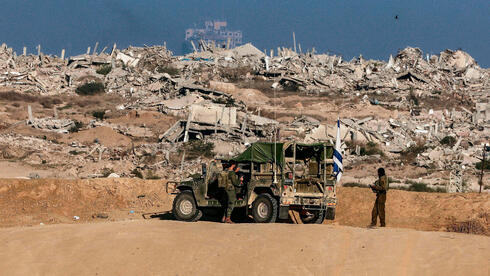IDF fears being stuck along ceasefire lines as Hamas rebuilds, combat restrictions dr

Hamas terrorists operating bulldozers, accompanied by Red Cross personnel, located and returned the bodies to Israel. Similar operations are expected in other IDF-controlled areas along what the military calls the “yellow line,” as Israel works to retrieve the last of the hostages still missing in the territory.
Defense officials said allowing Hamas to search for and recover the bodies is faster than sending in Israeli troops, since the group has detailed knowledge of where hostages were buried during the fighting. Hamas is believed to know the locations of about half of the remaining bodies.
If the organization claims it has no further information — partly because those who guarded the sites were killed — Israel’s security and political leadership will convene a special assessment. “In such a situation, we will know whether Hamas is telling the truth or lying about the locations,” a senior official said. “But a scenario in which not all the hostages are returned is realistic.”
Hamas continues to plant explosives daily near tunnel shafts and routes in areas under Israeli control, about three to four kilometers from the border. The IDF’s Southern Command aims to reduce the number of tunnels there before pulling back to a new perimeter roughly 700 to 800 meters from the prewar border. Deep inside the Hamas-controlled parts of Gaza, major underground terror bases remain intact, though the ceasefire prevents Israel from launching new ground operations to eliminate them.
Since the truce began, IDF forces — including the Nahal Brigade — have found weapons such as a rocket launcher with 15 tubes in northern Gaza. “Hamas terrorists follow a fixed pattern — we initiate tunnel demolitions, and they fire anti-tank missiles and sniper rounds,” an IDF officer said. “But that won’t stop us. We don’t need U.S. approval to defend ourselves.”
Senior IDF officers have expressed concern that gaps in the U.S.-Israeli framework could delay the creation of an international force intended to replace Hamas rule in Gaza, alongside an alternative Palestinian administration described as a “technocratic government.” Officials fear a long-term freeze would cement the current situation, restricting Israel from renewing ground combat or imposing harsher sanctions beyond the continued closure of the Rafah crossing to Palestinian movement into Egypt.
Israel remains obligated to transfer large quantities of humanitarian aid into Gaza — about 600 trucks of fuel, gas, and food daily. Military officials have recommended slowing deliveries after several incidents in which soldiers were killed, but U.S. President Donald Trump, who brokered the truce, has refused to authorize the change despite requests from Prime Minister Benjamin Netanyahu.
Phase B of the agreement is expected to include funding for reconstruction projects in Gaza. “Most residents of the Strip have no homes,” a senior defense official said. “There are signs of progress, such as the establishment of a U.S. command center in Kiryat Gat and a joint operations room coordinating civilian moves, but we haven’t crossed the Rubicon toward a full agreement. A freeze would only help Hamas rebuild, rearm, and seize much of the humanitarian aid we send.”
Officials warn that a prolonged stalemate could also serve political figures in Israel who favor retaining territory in Gaza. Some have suggested reestablishing Israeli settlements in parts of the Strip under military control, which would effectively reverse Israel’s 2005 disengagement.
Security officials admit that the aid distribution network, jointly managed by Israel and the United States, has largely stopped functioning. Hamas, they said, now controls more than half of the Gaza Strip, reestablishing its authority, eliminating rivals, and signaling to residents that it intends to stay in power.
The new U.S.-Israeli coordination mechanism for IDF strikes in Gaza is still operating slowly. The rules of engagement allow Israeli troops to fire only if armed terrorists cross the yellow line or approach it closely. Unarmed Palestinians who continue advancing after warning shots may be targeted from the air. Hamas terrorists who do not pose an immediate threat are monitored and documented for future intelligence purposes.
“The situation is not sustainable,” an IDF officer said. “If there’s no progress toward a comprehensive deal, we’ll face a growing risk to our forces, to civilians, and to international legitimacy. The current reality helps Hamas and moves us further from our goal — dismantling Hamas’s control and weapons in Gaza. Two million Gazans aren’t going anywhere.”
Source link

